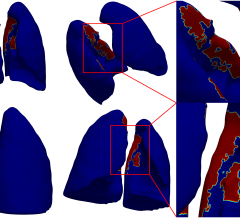March 30, 2011 – Understanding that angioplasty is safe may encourage additional studies for its use as a treatment option for individuals with multiple sclerosis, say researchers at the Society of Interventional Radiology's 36th Annual Scientific Meeting in Chicago. Angioplasty is a medical treatment used by interventional radiologists to widen the veins in the neck and chest to improve blood flow.
"Angioplasty—the nonsurgical procedure of threading a thin tube into a vein or artery to open blocked or narrowed blood vessels—is a safe treatment,” said Kenneth Mandato, M.D., an interventional radiologist at Albany Medical Center in Albany, N.Y. “Our study will provide researchers the confidence to study it as an MS treatment option for the future.”
In a retrospective study, 231 multiple sclerosis (MS) patients (age range, 25 to 70 years old; 147 women, 84 men) underwent this endovascular treatment of the internal jugular and azygos veins with or without placement of a stent (a tiny mesh tube).
"Our results show that such treatment is safe when performed in the hospital or on an outpatient basis—with 97 percent treated without incident," Mandato said. "Our study, while not specifically evaluating the outcomes of this endovascular treatment, has shown that it can be safely performed, with only a minimal risk of significant complication. It is our hope that future prospective studies are performed to further assess the safety of this procedure."
Complications included abnormal heart rhythm in three patients and the immediate re-narrowing of treated veins in four patients. All but two of the patients were discharged within three hours of receiving this minimally invasive treatment.
About 500,000 people in the United States have MS, generally thought of as an incurable, disabling autoimmune disease in which a person's body attacks its own cells.
"There are few treatment options that truly improve the quality of life of those with the disease, and some of the current drug treatment options for MS carry significant risk," said Mandato. In 2009, Paolo Zamboni, a doctor from Italy, published a study suggesting that a blockage in the veins that drain blood from the brain and spinal cord and return it to the heart (a condition called chronic cerebrospinal venous insufficiency or CCSVI) might contribute to MS and its symptoms. The idea is that if these veins were widened, blood flow may be improved, which may help lessen the severity of MS-related symptoms.
The Society of Interventional Radiology (SIR) issued a position statement last fall supporting high-quality clinical research to determine the safety and effectiveness of interventional MS treatments. It recognized that the role of CCSVI in MS and its endovascular treatment by an interventional radiologist via angioplasty and/or stents to open up veins could be transformative for patients.
"This is an entirely new approach to the treatment of patients with neurologic conditions, such as multiple sclerosis. The idea that there may be a venous component that causes some symptoms in patients with MS is a radical departure from current medical thinking," said Gary P. Siskin, M.D., FSIR, an interventional radiologist and chair of the radiology department at Albany Medical Center and the co-chair of the SIR research consensus panel on MS that was held in October.
"It is important to understand that this is a new approach to MS. As a result, there is a healthy level of skepticism in both the neurology and interventional radiology communities about the condition, the treatment and the outcomes," said Siskin. "Interventional radiologists have been performing venous angioplasty for decades and have established themselves as pioneers in this area of vascular intervention. Patients are learning about this therapy and the role of interventional radiology in venous angioplasty through the Internet. They are discussing it among themselves—through blogs and social networking sites—and then turning to interventional radiologists for this treatment. This is a new entity and one where researchers are clearly very early in their understanding of both the condition and the treatment."
SIR's position statement agrees with MS advocates, doctors and other caregivers that the use of any treatment (anti-inflammatory, immunomodulatory, interventional or other) in MS patients should be based on an individualized assessment of the patient's disease status, his or her tolerance of previous therapies, the particular treatment's scientific plausibility, and the strength and methodological quality of its supporting clinical evidence. "When conclusive evidence is lacking, SIR believes that these often difficult decisions are best made by individual patients, their families and their physicians," notes the society's position paper, "Interventional Endovascular Management of Chronic Cerebrospinal Venous Insufficiency in Patients With Multiple Sclerosis: A Position Statement by the Society of Interventional Radiology, Endorsed by the Canadian Interventional Radiology Association." SIR stresses the importance for MS patients to continue an ongoing dialogue with their neurologists to discuss their treatment care.
While the use of angioplasty and stents cannot be endorsed yet as a routine clinical treatment for MS, SIR agrees that the preliminary research is very promising and supports studies aimed at understanding the role of CCSVI in MS, at identifying methods to screen for the condition and at designing protocols for exploratory therapeutic trials.
"If interventional therapy proves to be effective, MS patients should be treated by doctors who have specialized expertise and training in delivering image-guided venous treatments," said Siskin. Interventional radiologists pioneered angioplasty and stent placements and use those treatments on a daily basis in thousands of patients with diverse venous conditions.
Mandato noted that research still needs to be done concerning patient selection, technique and the outcomes after this procedure, including improvement in symptoms and quality of life and the durability of the response.
For more information: www.SIRweb.org


 August 29, 2025
August 29, 2025 









